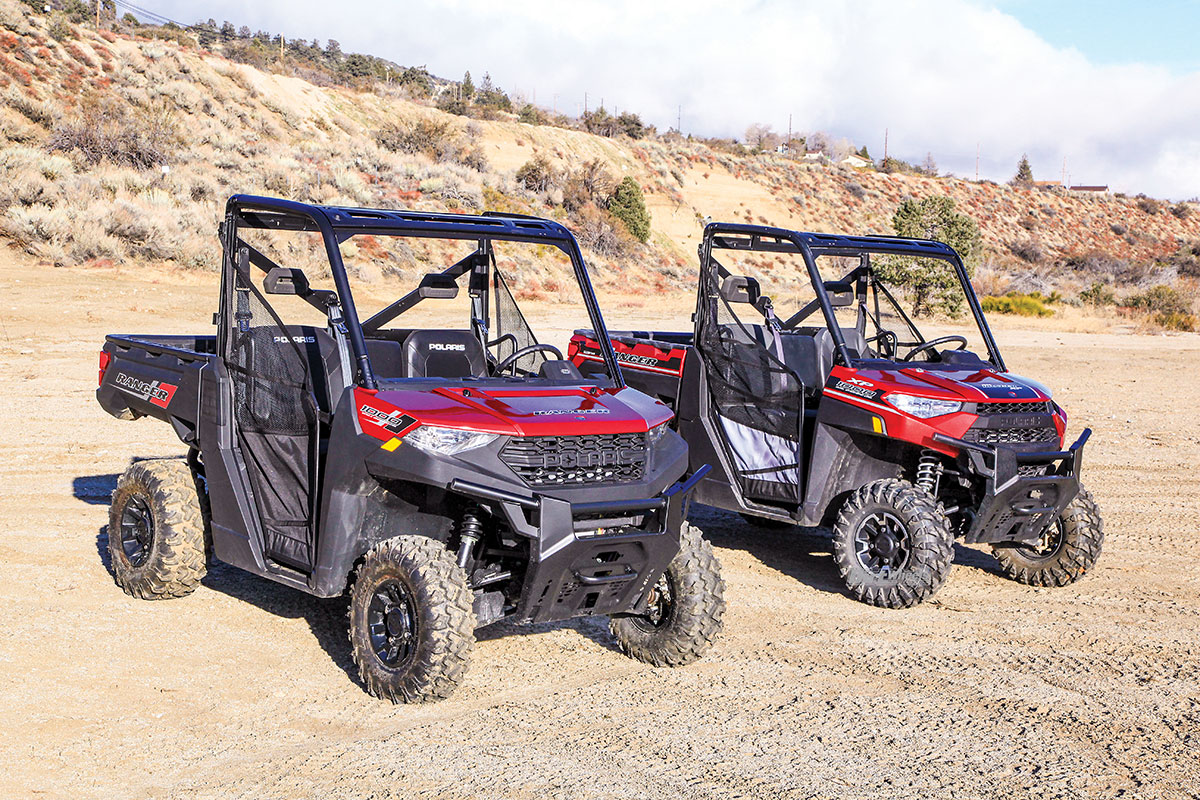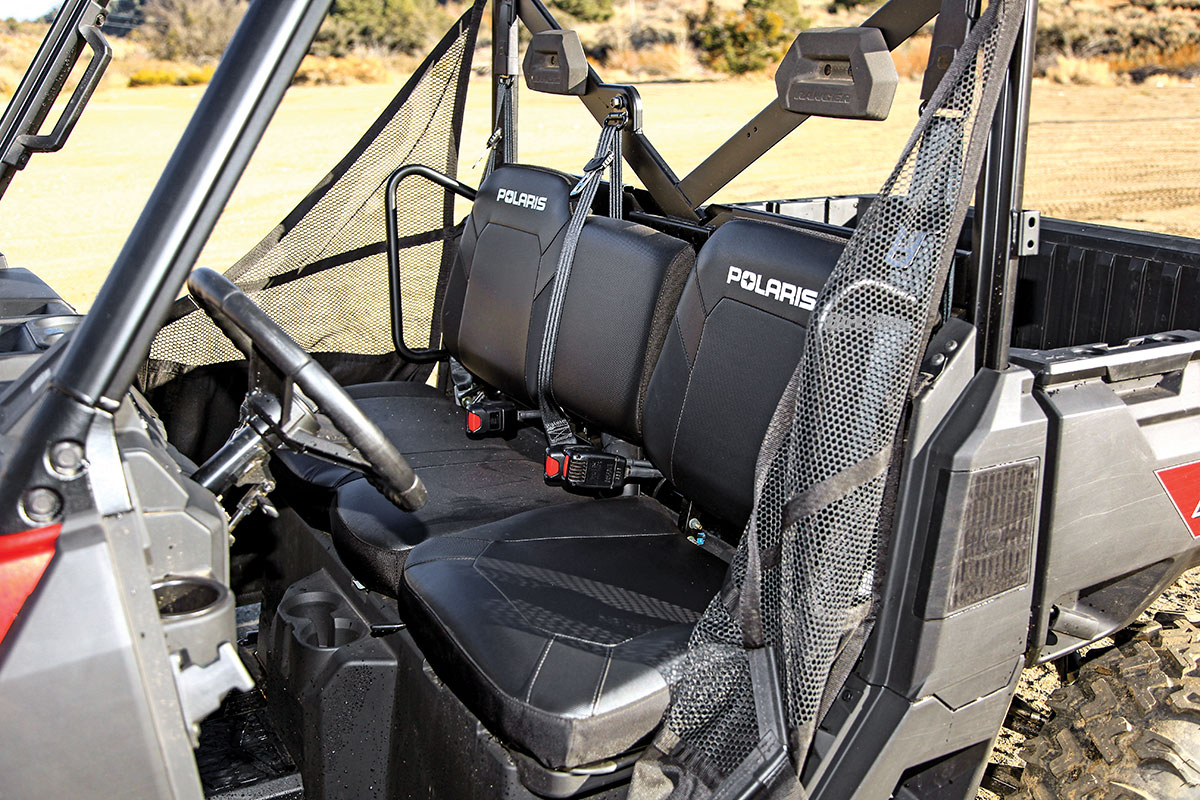RANGER COMPARISON: 1000 PREMIUM vs. XP 1000 PREMIUM
RANGER COMPARISON
Win a free set of tires and wheels by taking our 2021 Readers Survey HERE.
With so many versions to choose from, we thought a Ranger comparison could shed some light on what model is right for you. The Polaris Ranger series has been the driving force for the company’s utility recreation sales. When Polaris first released the Ranger XP 1000, it continued sales of the Ranger XP 900, the machine the 1000 had grown up from. The XP 900 was a company best seller, and there was little motivation to mess with it. Even when Polaris updated the Ranger XP 1000 in 2018, the all-new machine was joined in the line by the venerable Ranger XP 900. Now, though, the Ranger 1000 (no XP in the name) finally upgrades and replaces the Ranger XP 900. Polaris fully intends to sell both in the line, and it is a bit confusing, since they look much alike now, and there is a $1,900 difference between our test machines. Both are Premium models, meaning they have EPS, cast-aluminum wheels and upgraded seating. The price difference could be much larger if you select the Ranger 1000 base model without EPS or fancy wheels.

In 2018 the three-seat Ranger XP 1000 was the only one to get the then-new one-piece stronger frame, revised styling and bodywork, and performance changes. The multitude of changes made the Ranger XP 1000 more rugged for work, but also more refined, so it was a better companion for play and recreation.

WHAT IS THE SAME?
Both machines have the 25-percent-stronger one-piece frame that was such a big deal when it was released, and it includes fully sealed chassis bushings and bearings to aid performance and longevity. The underside of the chassis is nearly fully sheathed with a skid plate close to 50-percent larger than the one that protected the 2017. Areas not covered by the skid plate have been closed off to prevent the underside of the machine from catching and holding mud. Protection doesn’t end with the skid plate. The front of the machine is guarded by a massive bumper that Polaris claims is the biggest in the industry. It has coverage for the entire lower front of the machine, including the A-arms and steering parts. There is already a winch mount and a bar to attach a snowplow. You don’t get a bumper that large on the Ranger base model, but since the two we are comparing are Premium versions, they both have the large bumper.

They share the same modern and contemporary styling, but the body parts are not identical, though. The XP 1000 has more areas for body color. You will find a 999cc engine paired with a CVT behind both cabs. The drivetrain includes 2WD, 4WD and Turf mode that opens the rear differential to prevent rutting delicate surfaces.

Compared to past XP 900s and pre-2018 Ranger XP 1000 models, the new machines are both quieter in-cab with less engine noise. Even in identical trim packages, the Ranger XP 1000 is quieter than the Ranger 1000. The XP’s CVT and engine intakes are under the hood, and the Ranger 1000 has grate-covered intakes in the B-pillar right behind the cab. In terms of capacity and physical size, they both match with 1,000 pounds of bed capacity and a whopping 2,500 pounds of towing capability. They also share width, overall length and wheelbase. In addition to the normal versions and the High Lifter and NorthStar editions, there are available factory-installed upgrade packages: Ride Command, Back Country, Winter Prep, Cab Upgrade and an MB Quart Audio Upgrade. Suffice it to say, you can get either Ranger in the exact way you want it.

WHAT IS DIFFERENT?
One of the big differences in our Ranger comparison is that the Ranger 1000 starts at $12,999, and by any measure that is a lot of value, even without EPS and cast wheels. The base model also comes with 25-inch tires. With any of the higher trim versions like our $14,999 Premium, it has 26-inch tires, while all normal versions of the Ranger XP 1000 have 27-inch tires. The lowest-priced Ranger XP 1000 is $16,899.
While the Ranger 1000 has 10 inches of wheel travel, the XP 1000 has 11 inches. The added inch of travel and inch-larger tires on the XP explain the one-inch difference in ground clearance and overall height. Ground clearance is 12 inches for the Ranger 1000 and 13 inches for the Ranger XP 1000.
You will find the biggest difference in the engine area. Both have the same displacement, but the Ranger 1000 has a single-overhead-cam cylinder head designed for low-rpm power. Making better power down low makes for an effective work machine, but it also drops the in-cab sound levels for work or recreation. Power output is rated at 61 horsepower with 55 pound-feet of torque. The XP 1000 has a double-overhead cam head design, and it is good for 82 horsepower and 62 pound-feet of torque. If you are just working your property, hauling things, towing a trailer, pulling logs around or other general work, you may not even notice the power difference. The same is true of tight or technical trails.
If you get out and stretch the legs of both machines, the additional 25-percent-more horsepower feels like even more. Polaris equips the XP 1000 with a three-position switch on the dash: work, standard and performance settings. Even the work setting feels zippy in comparison on an open trail.
While the suspension isn’t radically new, there were steering improvements in 2018. The 2018 XP 1000 gained a sharper turning radius, thanks to 19-percent-tighter steering. The turning radius on both of our machines is the same. The steering is quick, but it is speed sensitive. We aren’t sure whether to thank the speed-sensitive feature or the one-piece frame, but the steering felt solid and the front of the machine was predictable. In all conditions the XP 1000 is just a little more smooth riding with the larger tires and greater travel.


POWER WARS
Having an 82-horsepower, parallel, twin-cylinder engine means that the Ranger XP 1000 has plenty of performance. It has a clutch ratio Polaris calls the largest in the industry. Polaris took lessons learned with the RZR Turbo to ensure that the belt stays cool, and the beefy belt is borrowed from the RZR Turbo. Until we drove the XP 1000, we had no issues with the Ranger 1000 power output. With either machine in the Ranger comparison, you could literally tow a small camping trailer behind when you go hunting or camping.

THE INSIDE
Both machines have semi-bench seating for three with seat belts, and the seats are nicely padded and comfortable. The seats aren’t bolstered like Polaris RZR or General, but you aren’t expected to drive the machine like those sportier models. The shifter is dash-mounted, and the twin-sweep gauge package from the General is used in the Ranger XP, while the Ranger 1000 has a 4-inch LCD display. The dash and interior are set up nicely on both machines with cup holders designed to accept mugs with a handle. There is a gallon more normal storage on the XP 1000, but the big difference is that the Ranger 1000 bench seat is solid underneath, but the XP 1000 has a large open area under the passenger seat for storage, and the floor has a molded-in ring suitable for holding a 5-gallon bucket. It is claimed to be an ideal spot for a dog to ride. We used it as the perfect spot for a camera bag.

HOME WITH THE RANGER
One of the major goals for both Rangers was to make them better companions for recreation while enhancing their ability to work. A secondary goal was to make the Ranger 1000 a worthy replacement for the wildly popular Ranger XP 900. We’d say that Ranger 1000 is a major upgrade from the XP 900. It is quick and nimble on trails and roads, with light steering that feels planted and accurate. The suspension honestly feels like there is more than 10 inches on tap. We were able to push the pace and feel totally comfortable. With IRS on all four corners, it soaks up angled roots, logs or ledges without rattling the passengers. The Ranger is as wide as machines in this class go at 62.5 inches, so stability is fine on cambers.
The upright seated riding position is comfortable for a rider in excess of 6 feet tall, but suited to shorter pilots equally well. The new, deeper, softer seat is very accommodating. Even though the ride was littered with soft and hard ruts, roots and logs, we rarely had clearance issues. Turning around in the brush and woods was always easy. We are confident that the Ranger can handle the ranch, farm or construction site equally well.
All of those same traits can be attributed to the Ranger XP 1000 as well. It is comfortable, rides even better than the Ranger 1000, and it has more ground clearance. It has a clear and easy-to-feel performance advantage for recreational driving, but the difference is almost nil at a work pace. We like the three power modes, but understand why they were not included on the Ranger 1000.


CONCLUSION
In this Polaris Ranger comparison It is easy to see why the Ranger XP 900 was so strong in this category. The Ranger 1000 that replaces it has more room, more power, and superior comfort. It also carries and tows more. It is a solid, effective machine for work and for fun. It feels like it was designed to a standard and not to a bottom line. On the other hand, the Ranger XP 1000 costs more, but it rewards with better ride comfort, as well as sporty and fun engine performance. It is powerful and responsive, but the CVT hook-up is super smooth and controllable, and that can be fine-tuned with the three-position dash switch. This is a utility machine that we can readily have fun with. For us, doors would be preferred to the door nets on both machines, but those are easily available. We don’t own a farm or ranch, so the XP 1000 is worth the extra cost to us.

RANGER COMPARISON: 1000 PREMIUM RANGER XP 1000 PREMIUM
MSRP $14,999 $16,899 (starting price)
Engine 999cc SOHC twin four-stroke 999cc DOHC twin four-stroke
Fuel system Electronic fuel injection Electronic fuel injection
Fuel capacity 11.35 gal 11.5 gal.
Starting system Electric Electric
Final drive Shaft Shaft
Suspension/wheel travel:
Front Dual A-arm/10.0” Dual A-arm IRS 11.0”
Rear Dual A-arm IRS/10.0” Dual A-arm IRS/11.0”
Tires:
Front 26×9-12 27×9-12
Rear 26×11-12 27×11-12
Brakes:
Front Hydraulic disc Hydraulic disc
Rear Hydraulic disc Hydraulic disc
Wheelbase 81.0” 81”
Length/width/height 120”/62.5”/76” 120”/62.5”/77”
Ground clearance 12.0” 13.0”
Payload 1,500 lb. 1,500 lb.
Towing capacity 2,500 lb 2,500 lb.
Curb weight 1537 lb. 1565 (dry) lb.
Color Sunset Red Metallic, Matte Polaris Pursuit Camo, Sunset Red, Military Tan, Matte Titanium Matte Titanium Metallic, Suede Metallic
CONTACT: www.polaris.com


Comments are closed, but trackbacks and pingbacks are open.